#dajin
Explore tagged Tumblr posts
Text
the sillies

595 notes
·
View notes
Text




I made these bc I couldn’t find any on Pinterest so here
95 notes
·
View notes
Text

[241108] Yujin & Dayeon @ Incheon Airport #DaJin
On the way to Japan to attend SUPERPOP JAPAN 2024 on [241109] & [241110].
#Yujin#241108#Choi Yujin#Incheon Airport#DaJin#Dayeon#최유진#유진#SUPERPOP JAPAN 2024#CLC#Kep1er#Airport fashion
23 notes
·
View notes
Text
official_kep1er: [🎶Tiktok] ✨오카네 카세구 오레라와 스타✨ https://vt.tiktok.com/ZS2PgFMvq/
#choi yujin#kim dayeon#kep1er#yujin#dayeon#femaleidol#최유진#유진#김다연#다연#femaleidols#tiktok#video#t:update#kep1going on#dajin#megan thee stallion#mamushi challenge#kpop#ggnet#kep1ernetwork#femadolsedit#kep1ernet#ggnetwork
8 notes
·
View notes
Text

Watched Suzume and caught a small reference to Muta on the train in Whisper of the Heart 🐈⬛️🐈
4 notes
·
View notes
Text
UP FOR ADOPTION!

1 note
·
View note
Text
Things that I find interesting in Wuthering Waves.
The character tacet mark moves and gets bigger when resonance liberation is ready.
Characters look around when sitting.
Rover gets dizzy using Havoc because is the most self damaging element, the same happens with Dajin, but she loses hp.
Some NPC soldiers can be called to help you or you can follow them, the things that they kill will be transferred to you. Also if they die, they will not reset unless you log again, in lore they’re dead and a new soldier is replacing them.
NPCs will salute you if they’re guarding the entrance of military bases.
Is implied that Rover visited Solaris-3 at least 3 times, one time saving Huanglong, an unknown time and the actual one.
When Sanhua sees the frequencies in normal resonators she sees their overclocked form. Only the ones linked to the centinels and Rover look normal.
The 1.0 Jinzhou city is not the capital of Huanglong, the country has 5 cities. Jinhsi was visiting the capital during the 3 days break. Also Huanglong is not the only country.
In the south part of the map players will find more scientists, travelers and Exiles and in the north players will find more TD's and more Fractidus.
This is because the military base at Desorock Highland and the military force of Jinzhou work as a barrier of the Threnodian advance. Jinzhou is the bordering city.
Yangyang got feathers in her hair because she overcloked, she is very sensitive to the frequencies of the wind and air so she can “read the wind”.
Genshu Lin was the one that stopped alone the first formation of the Threnodian embodiment of War.
167 notes
·
View notes
Text
Fishskin Robes of the Ethnic Tungusic People of China and Russia
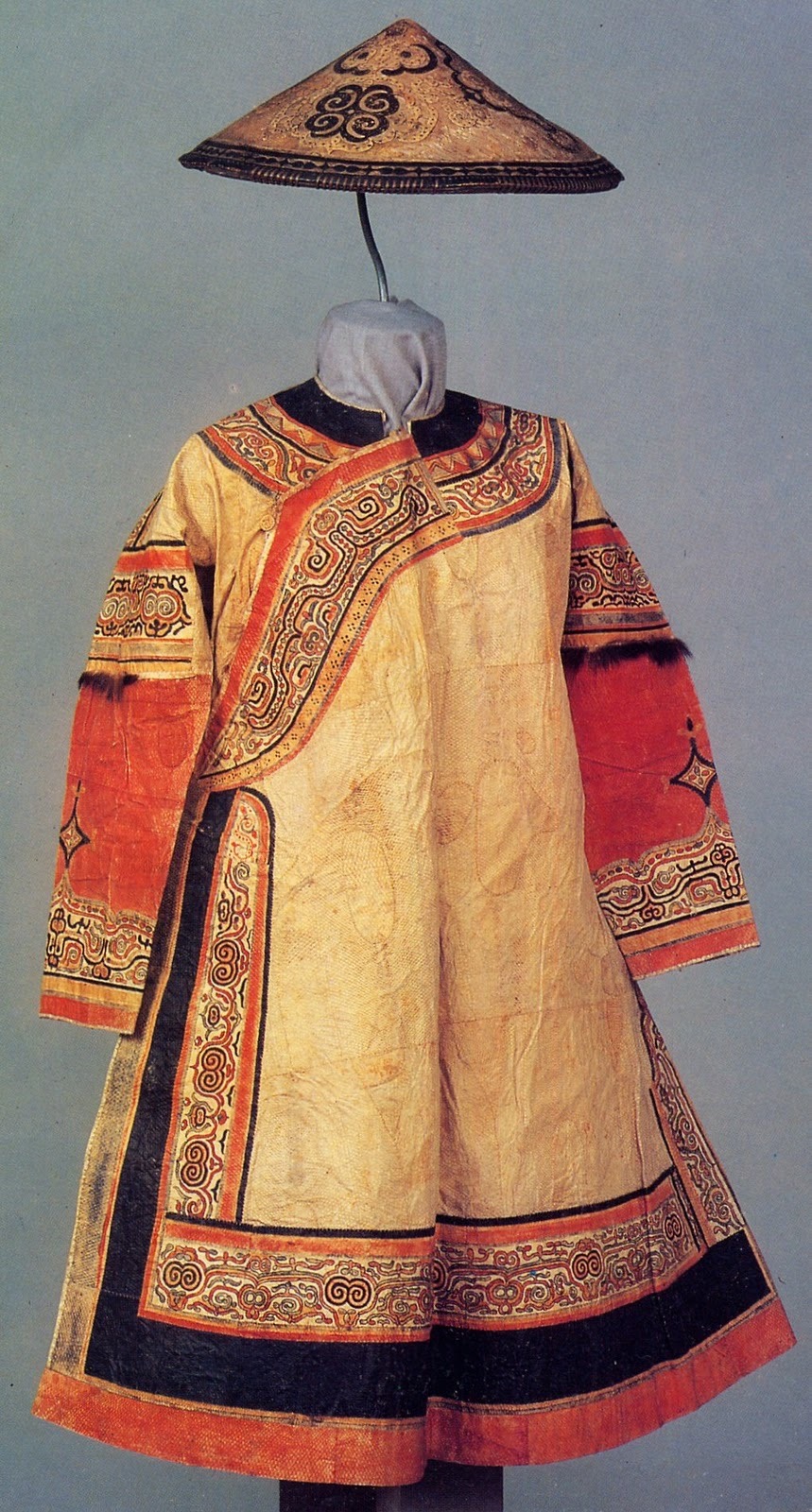
Oroch woman’s festive robe made of fish skin, leather, and decorative fur trimmings [image source].
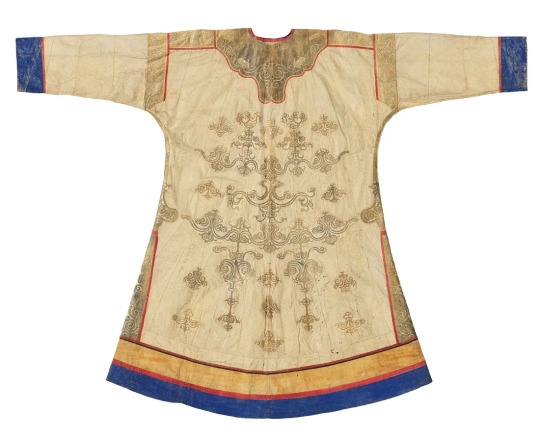
Nivkh woman’s fish-skin festival coats (hukht), late 19th century. Cloth: fish skin, sinew (reindeer), cotton thread; appliqué and embroidery. Promised gift of Thomas Murray L2019.66.2, Minneapolis Institute of Art, Minnesota, United States [image source].
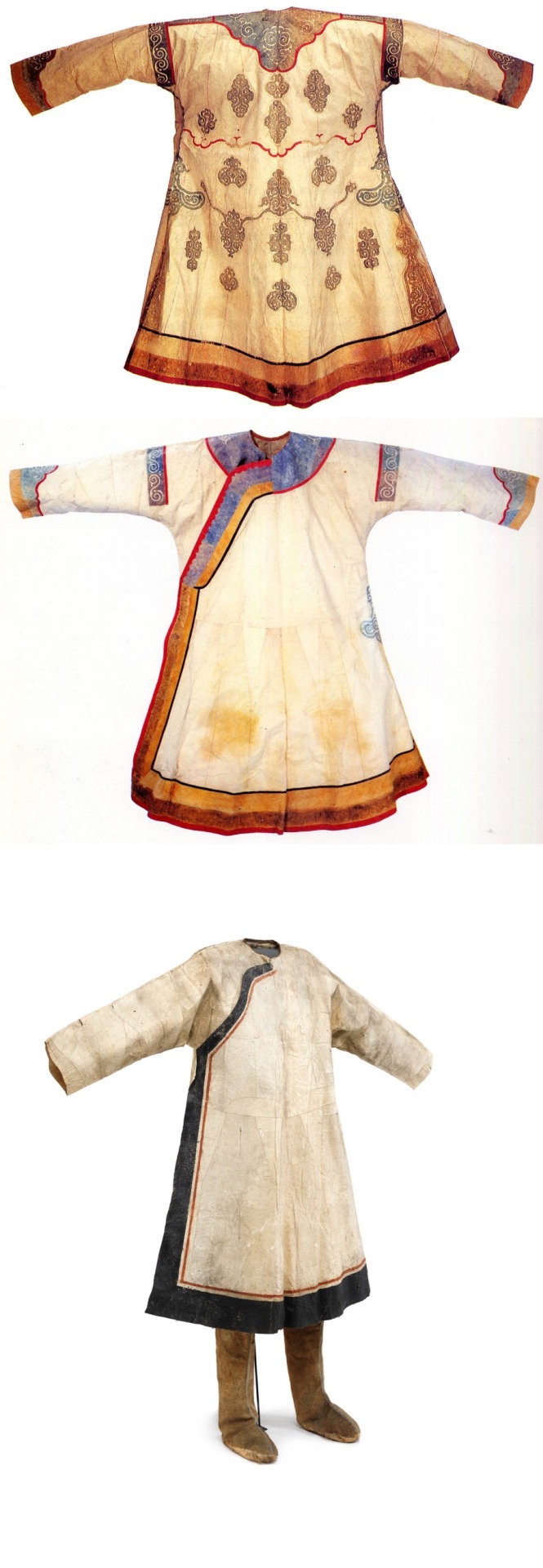
Back view of a Nivkh woman’s robe [image source].
Front view of a Nivkh woman’s robe [image source].
Women’s clothing, collected from a Nivkh community in 1871, now in the National Museum of Denmark. Photo by Roberto Fortuna, courtesy Wikimedia Commons [image source].
The Hezhe people 赫哲族 (also known as Nanai 那乃) are one of the smallest recognized minority groups in China composed of around five thousand members. Most live in the Amur Basin, more specifically, around the Heilong 黑龙, Songhua 松花, and Wusuli 乌苏里 rivers. Their wet environment and diet, composed of almost exclusively fish, led them to develop impermeable clothing made out of fish skin. Since they are part of the Tungusic family, their clothing bears resemblance to that of other Tungusic people, including the Jurchen and Manchu.
They were nearly wiped out during the Imperial Japanese invasion of China but, slowly, their numbers have begun to recover. Due to mixing with other ethnic groups who introduced the Hezhen to cloth, the tradition of fish skin clothing is endangered but there are attempts of preserving this heritage.
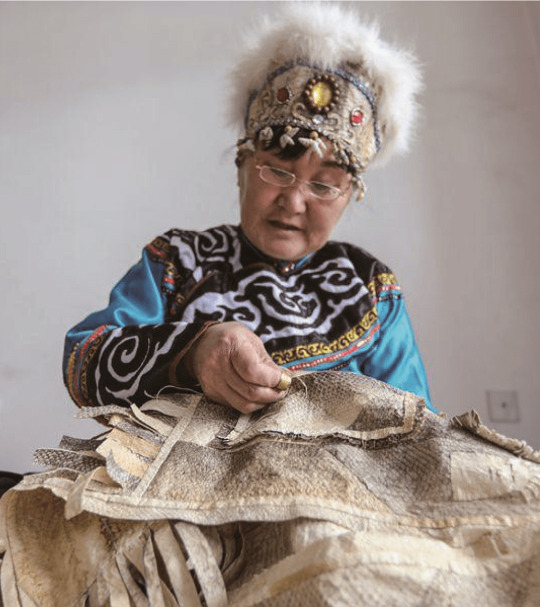
Hezhen woman stitching together fish skins [image source].


Top to bottom left: You Wenfeng, 68, an ethnic Hezhen woman, poses with her fishskin clothes at her studio in Tongjiang, Heilongjiang province, China December 31, 2019. Picture taken December 31, 2019 by Aly Song for Reuters [image source].
Hezhen Fish skin craft workshop with Mrs. You Wen Fen in Tongjian, China. © Elisa Palomino and Joseph Boon [image source].
Hezhen woman showcasing her fishskin outfit [image source].
Hezhen fish skin jacket and pants, Hielongiang, China, mid 20th century. In the latter part of the 20th century only one or two families could still produce clothing like this made of joined pieces of fish skin, which makes even the later pieces extremely rare [image source].
Detail view of the stitching and material of a Hezhen fishskin jacket in the shape of a 大襟衣 dajinyi or dajin, contemporary. Ethnic Costume Museum of Beijing, China [image source].
Hezhen fishskin boots, contemporary. Ethnic Costume Museum of Beijing, China [image source].
Although Hezhen clothing is characterized by its practicality and ease of movement, it does not mean it’s devoid of complexity. Below are two examples of ornate female Hezhen fishskin robes. Although they may look like leather or cloth at first sight, they’re fully made of different fish skins stitched together. It shows an impressive technical command of the medium.
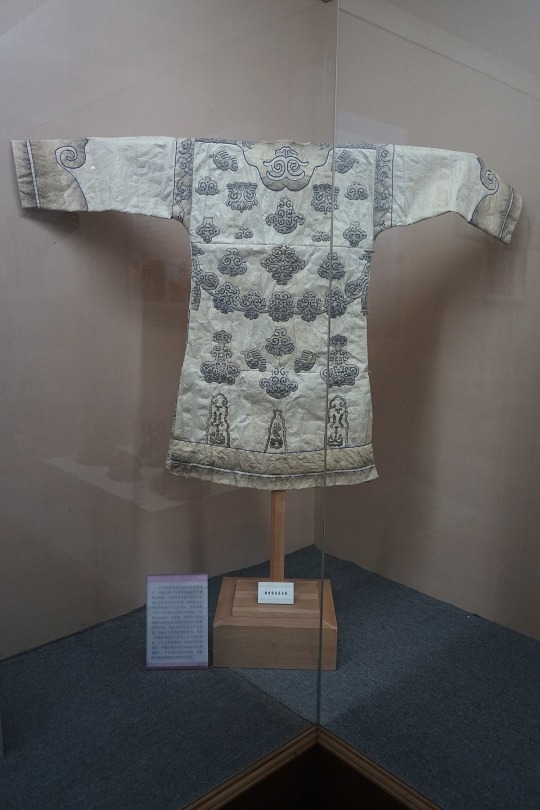
赫哲族鱼皮长袍 [Hezhen fishskin robe]. Taken July 13, 2017. © Huanokinhejo / Wikimedia Commons, CC BY 4.0 [image source].
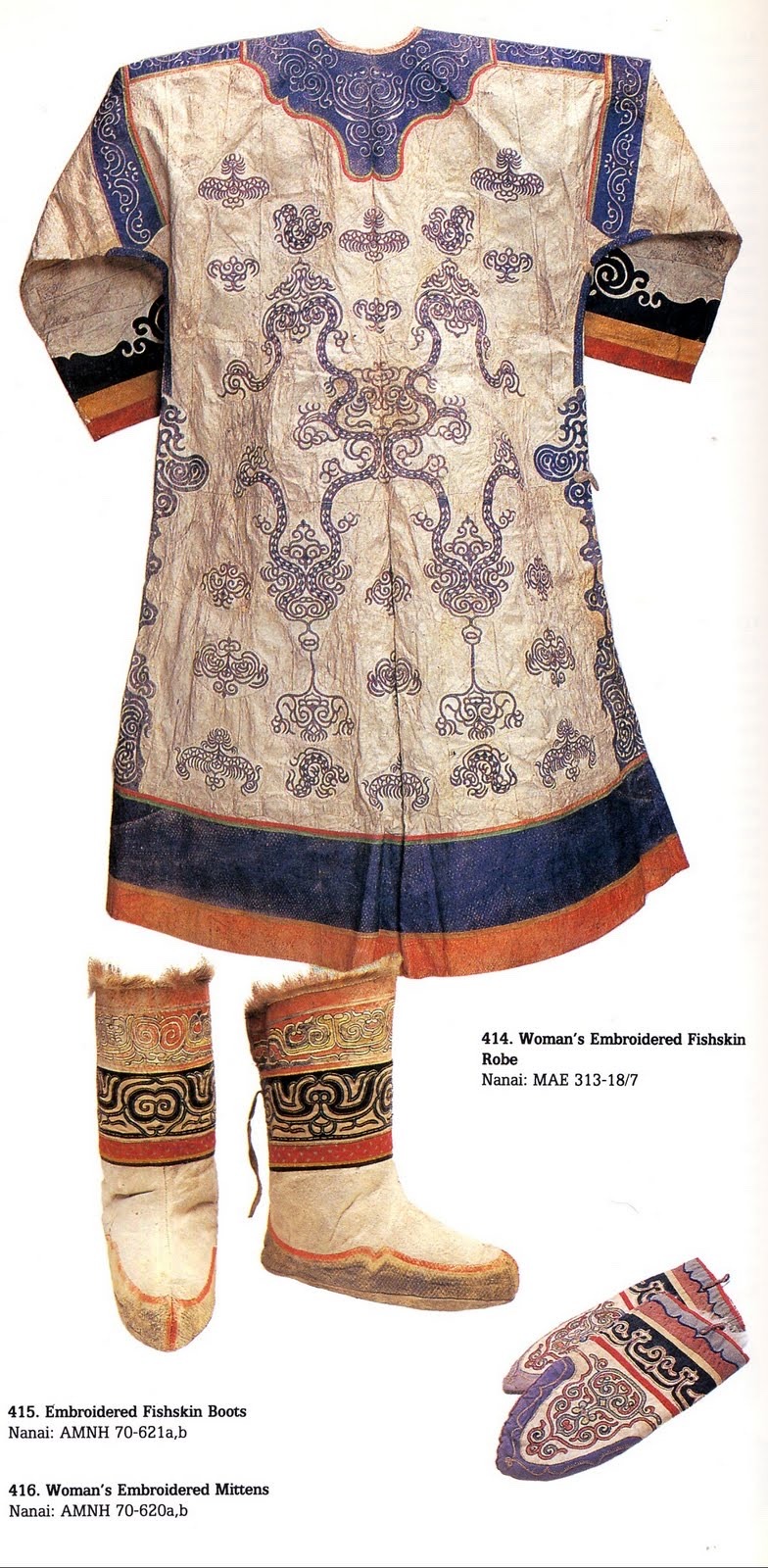
Image containing a set of Hezhen clothes including a woman’s fishskin robe [image source].
The Nivkh people of China and Russia also make clothing out of fish skin. Like the Hezhen, they also live in the Amur Basin but they are more concentrated on and nearby to Sakhalin Island in East Siberia.


Top to bottom left: Woman’s fish-skin festival coat (hukht) with detail views. Unknown Nivkh makers, late 19th century. Cloth: fish skin, sinew (reindeer), cotton thread; appliqué and embroidery. The John R. Van Derlip Fund and the Mary Griggs Burke Endowment Fund; purchase from the Thomas Murray Collection 2019.20.31 [image source].
Top to bottom right: detail view of the lower hem of the robe to the left after cleaning [image source].
Nivkh or Nanai fish skin boots from the collection of Musée du quai Branly -Jacques Chirac. © Marie-Lan Nguyen / Wikimedia Commons, CC BY 4.0 [image source].
Detail view of the patterns at the back of a Hezhen robe [image source].
Read more:
#china#russia#tungusic#hezhe#nanai#fishskin#ethnic minorities#nivkh#chinese culture#history#russian culture#amur basin#heilongjiang#east siberia#ethnic clothing
1K notes
·
View notes
Text
Does the Rover seem hollow to anyone else?
The trailblazer mc is a trash goblin.
The traveler has a rabbit hole full of lore.
But the rover seems odd?
Not without personality, I mean canonically they're considered a very intelligent person with a lot of feats of their strategic abilities but it kind of comes off as manipulative to me.
Changli, Jinshi's teacher; met the rover as a child and Jinzhou's sentinel refers to the rover as master, the same sentinel that brought a dead baby back to life.
Which can be the reason why Jinhsi was practically expecting us.
The rover is indirectly responsible for the existence leader of the nation they just happened to land in.
The Somnium Labyrinth event lets us understand that the power to go through people's dreams was somehow invented by the rover.
Dreams of people that we haven't even met yet seeing as we can play as Calcharo, Dajin and Yuanwu.
The entire existence of the black shores is because of the rover.
They have influenced two people into working for them the shore keeper and Camellya both non human characters that have devoted themselves to the rover.
I just want the rover's thoughts on people that they have influenced and honestly I just hope that the rover isn't evil because that is so boring.
You can be manipulative and still be a good person at heart, I mean look at Sunday or a good portion of the DC heroes.
8 notes
·
View notes
Text
Gonna rewatch and hammer out my thoughts about Dajin and Souta's shitty grandad, like from the brief time we see them interact they have a history (hard to not come to that conclusion when he outright greated him as a friend) and I wonder if the grandad was the one to place Dajin as the keystone or is it something mentioned in the book that Souta has
#suzume#suzume no tojimari#i love the little kitty#wish Suzume found a way to save both Souta and him
3 notes
·
View notes
Text
youtube
[TRAD ITA] 240709 TWEET DI BTS OFFICIAL:
"🎉ARMY🎉
[#BangtanBomb] Superato il 'Niente di preparato' 🍷 e oltre 'Halmyungsoo' 👥 nel luogo delle uscite dei variety show da solista di #Jin📹 #IlMigliorAmicoELaSuperStarMondiale🐹 (https://youtu.be/axUJ8fOnqsc)
#IlPacchetto_DellaBangtanBomb_PreparatoPer_IlGiornoDegliARMY #Un9LuglioPienoDiFelicità #ContenenteLeRegistrazioniDeiBangtan🎞️ #GiornoDegliARMY #UsciteFuoriBangtan💜 #AgliARMY #DaJin"
Traduzione a cura di Bangtan Italian Channel Subs (©Xina) | Trans ©btsinthemoment
3 notes
·
View notes
Text
BUCCHIGIRI?! discord server
do you like bucchigiri and/or jin marito and/or catboys and/or gay people.... consider joining a server made just for people like you!!! ^^ you'll find custom emotes and roles, fun channels and events along with a small but friendly community of bucchigiri fans! We talk about arajin and matakara kissing. JOIN NOW! (16+)

22 notes
·
View notes
Text
#Songs#music#bok dajib#Can’t find lyrics translations for this but it’s so light and cute anyways!#Spotify
0 notes
Text









[240615] Yujin Twitter update: Kep1er’s VOYA9E (Goodbye Kep1erving)
행복한 시간들💕
Happy times 💕
Source: https://x.com/official_kep1er/status/1801889065136185732
#Yujin#240615#Choi Yujin#Kep1erving#Kep1er’s VOYA9E (Goodbye Kep1erving)#CLC#Kep1er#Mashiro#YuShiro#Leaderz#DaJin#Dayeon
33 notes
·
View notes
Text


yujin update ☆ bubble messages
#choi yujin#shen xiaoting#kim dayeon#kep1er#yujin#xiaoting#dayeon#femaleidol#최유진#유진#沈小婷#小婷#샤오팅#femaleidols#bubble#kep1going#dajin#film#xiaojin#magic hour#kpop#ggnet#kep1ernetwork#femadolsedit#kep1ernet#ggnetwork
26 notes
·
View notes
Text
"Checkmate"
K • I • N • G
Namete moratte wa NG ichimou dajin
Ikki ni kokoro ubatte yarou
Kono kuchibiru hitotsu de
(You were bewitched by the lips)
Subete ga omou mama
K • I • N • G
Sore zore yaku wo enji unmei to yuu
Daihon ni shitagaeba ii dake (we are...)
Orera ga King of Voxxx
Sou da tsurakunai nani mo kowakunai
Ari no mama jijitsu uke ireru dake
Kimi ga warui toka sou yuu jigen de wanai
Tada me no mae ni zettai teki na
Ouja ga iru dake
"We are..."
K • I • N • G
Sou koe rarenai genjitsu boujaku bujin
Dare ni mo tomerarenu shihaisha
Kono kuchibiru no mahou ni
(You were bewitched by the lips)
Kimi wa nasusube ga naku
K • I • N • G
Shousha ga tsune ni shinjitsu
Sou yatte rekishi wa hitsuzen ni
Tsukurareru nara (we are...)
Orera ga King of Voxxx
Da da da muda muda muda da
Sou teikou shiyou ga mou muda da
Da da muda muda muda da
Sou teikou shiyou ga
Mou muda da
5 notes
·
View notes